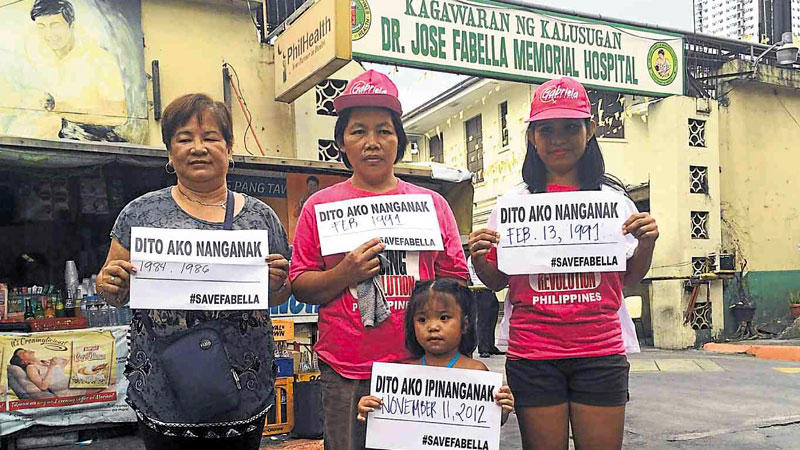
MOTHERS who have given birth at the world’s busiest maternity facility, the Dr. Jose Fabella Memorial Hospital, are joined by their daughters in a campaign to save the 65-year-old institution from being torn down. The DOH is planning to transfer the hospital to the nearby DOH compound on Rizal Avenue. JOCELYN R. UY
Nearly four years after she gave birth at the Dr. Jose Fabella Memorial Hospital in Manila, Marlyn Alcantara returned to the facility on Mother’s Day to protest its impending demolition and transfer.
While standing in front of the world’s busiest maternity hospital, Alcantara recalled giving birth in 2012 to her daughter, Rickshalyn.
“We ended up here at Fabella hospital because the cost of giving birth at the private hospital [near our house] was too [prohibitive] for us,” said the 25-year-old Alcantara who was also born in the government-run facility popularly known as a “baby factory” because of the sheer number of births recorded there.
In fact, her mother, Marie, told the Inquirer: “I gave birth to all my children here and I spent only around P200 or P300 each time.”
The hospital averages around 60 deliveries a day although the figure goes up to 80 during “peak season.”
Together with several other women who at one time or another had also given birth at the hospital, mother and daughter were among those who joined women’s rights group Gabriela in yesterday’s rally. The protest was in line with the “Save Fabella” campaign aimed at stopping the impending abolition and transfer of the 65-year-old facility.
“For poor mothers like us, we are worried that the new Fabella hospital will charge us higher fees. We don’t like a new hospital, we want it [to remain where] it stands because [this area is part of] the hospital’s history,” Alcantara said.
The hospital—the go-to maternity facility for the poor—can be found in the old Bilibid compound on Lope de Vega Street.
Philippine Health Insurance Corp. (PhilHealth) members who are confined there are not charged a single centavo except in cases when they exceed the state insurance’s case rate allocation.
For Health Secretary Janette Garin, the transfer and modernization of the hospital was nothing to be worried about.
“This is not under a PPP (public-private partnership). If the hospital will be run by a private company, of course [the owners] will be the ones who will profit from it because the patients will [have to] pay. Health services will become costly if you convert it into a PPP [project],” she said.
In an interview on Friday, Garin brushed aside talk of the facility being demolished, saying it would just be moved moved to a new, bigger building in the San Lazaro compound of the Department of Health (DOH) on Rizal Avenue, just 1.3 kilometers away.
The new Fabella hospital, which was projected to be finished in May 2017, will complete the proposed tri-medical complex at the DOH headquarters, where the San Larazo Hospital and Jose R. Reyes Memorial Medical Center are also located.
“The existing Fabella hospital will operate until after construction of the new structure is completed next year,” Garin told the Inquirer, saying that the DOH had engaged a third party company to assess the facility’s eight buildings following last month’s fire.
Based on the firm’s findings, 80 percent of four of the buildings had “reduced structural integrity,” prompting the Department of Public Works and Highways to recommend that these be “immediately vacated,” Garin said.
Oppositors had earlier suggested that the affected buildings undergo retrofitting to avoid disturbing the hospital’s operations. Garin, however, said that this would also entail about P400 million in expenditures as well as the transfer of some patients and employees.
According to her, giving Fabella a bigger and better home was more cost-effective than repairing the old hospital. The P1.5 billion modernization project was initiated during the term of Health Secretary Enrique Ona only to be delayed by legal obstacles, Garin said.
For now, Fabella would be allowed to continue operations although its bed capacity would be reduced to 150 for the safety of its patients. “A little movement there might cause the affected buildings to collapse and if that happens, I will be held responsible,” said Garin.
As for the employees working in the affected buildings, they will be temporarily assigned to other DOH-run hospitals nearby, including the Philippine General Hospital.